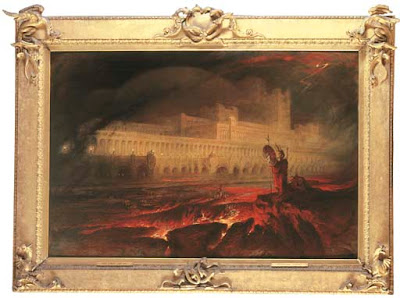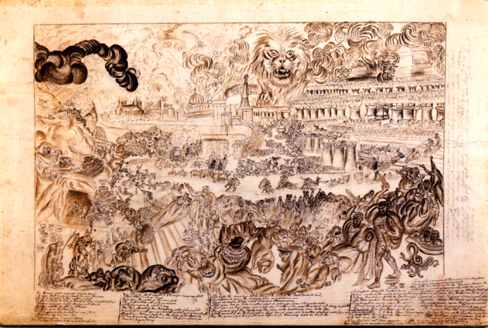I had an unexpected free day in London on Wednesday thanks to the strikes at Heathrow. It was lovely to be able to catch up with my friend Judith Clute, but I also wanted to take the opportunity to visit Apocalypse, an exhibition at Tate Britain. It is a collection of paintings and prints by the 19th Century artist, John Martin, who has had a profound influence on the art of the fantastic.

Martin began his career painting gothic landscapes in the style of the 18th Century, some of which are quite reminiscent of the vision of Gondor in the Lord of the Rings movies. His early work drew strongly on fantastical works from the classics, particularly Ovid’s Metamorphoses, and also more contemporary writers ranging from Byron to Bulwer-Lytton. His work has been cited as an inspiration by Ray Harryhausen, and you can see his influence most clearly in disaster movies such as The Day After Tomorrow and 2012.
As time went on and the Victorian era began to take hold, Martin’s work became more religious and more melodramatic. His primary inspirations became Milton’s Paradise Lost, and the Bible. The highlight of the exhibition is a massive triptych based on the Book of Revelation. To the right the world is destroyed in fire, to the left the New Jerusalem descends upon the plains of Heaven, and in the center is a detailed depiction of “The Last Judgment”. This, naturally, divides humanity into the Saved and the Damned. The former include Martin’s friends, people from history he admired, and people he needed to suck up to. Most prominent amongst the latter are Catholic clergy and the Whore of Babylon. While a fair amount of nakedness can be seen amongst the Damned, the Whore is depicted as a respectable, middle-aged matron, so I guess she’s based on someone Martin knew.

The Tate has provided a 10-minute audio-visual drama based on these paintings, with lights illuminating specific parts of them while the narration reads stentoriously from Revelation and perhaps Milton as well. Listening to it, I couldn’t help seeing the two groups in “The Last Judgment” being not the Saved and the Damned, but the Hypocrites and the Queers. The former would spend eternity in Heaven desperately trying to abide by enumerable pretty regulations (chief amongst which would be being white), lest they be cast down, while the latter would have a very long party, and lots of sex.
My favorite painting from the exhibition is “Pandemonium”, which is the palace of Satan from Paradise Lost. H.P. Lovecraft was a fan of Martin’s illustrations of the Milton epic, referring, in his inimitable style to:
“… the darkly thunderous, apocalyptically majestic & cataclysmically unearthly power of one who, to me, seemed to hold the essence of cosmic mystery… Night; great desolate pillared halls; unholy abysses & blasphemous torrents; terraced titan cities in far, half-celestial backgrounds whereon shines the light of no familiar sky of men’s knowing; shrieking mortal hordes borne downward over vast wastes & down cyclopean gulfs.â€
Certainly a common feature of the work of both Martin and Lovecraft is the insignificance of humans in the face of the majesty of the universe, and the mighty powers that rule it. I, however, love “Pandemonium” for an entirely different reason. As the Tate’s description of the painting points out, the palace bears a distinct resemblance to another ornately gothic construction that stands next to a mighty river, not at all far from where the painting now hangs.
(Both buildings use the Perpendicular Gothic style. Construction of the Palace of Westminster didn’t begin until 1840, and “Pandemonium” was painted in 1841, but Martin also worked as an engineer, including helping redesign London’s sewers, and probably had access to the plans for the new parliament building.)

(That image, by the way, is linked from British Paintings, which looks to be a fine little blog. It is one of the few images I could find that also showed the magnificent frame that Martin created for the picture.)
I have to admit, though, that my favorite painting from the exhibition is not by John Martin, but by his brother. Jonathan is much more famous for having been sentence to an asylum after having set fire to York Minster. While he was in Bedlam he produced this painting, “London’s Overthrow”.

There’s more about Jonathan Martin, and the image I’m linking to, here.
The Tate is also currently running an exhibition of paintings by the Romantics, yet more artists who have had a profound influence on our vision of the fantastic. That includes dear Rossetti, a gentleman beloved by curvaceous redheads the world over. The painting I was particularly pleased to see, however, was “The Death of Chatterton†by Henry Wallis It depicts the death of a teenage prodigy, Thomas Chatterton. Chatterton was from Bristol, and the house in which he was born is just across the road from the hotel where BristolCon is held. Harriet Castor has more on the story.

This looks fabulous – and I wouldn’t have known about it if I hadn’t read this – so thank you!